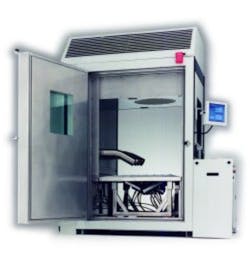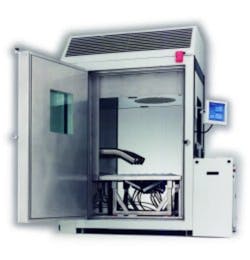We know from observation, and some of us from experience, that a highly accelerated lifestyle takes its toll on our bodies. Too much nightlife and not enough sleep are likely to cause a body part or two to fail sooner or later. Human bodies are not built to operate for long periods of time in the fast lane.
The same could be said about the products we design. Fortunately, though, you can use this fast-lane exposure to your advantage in product evaluation. By operating a product in the fast lane for a short period of time, you can accelerate infant mortality and save the cost and embarrassment of early product failure in the hands of your customer.
If you operate the product in an even faster lane until you have simulated the projected total life, you can detect almost all of the weak spots and correct your design to make it strong. Fast-lane product testing to simulate a product’s entire life is highly accelerated life testing (HALT). Fast-lane screening for a short time to detect infant mortality is called highly accelerated stress screening (HASS).
How HALT and HASS Are Related
The acronyms HALT and HASS were coined by Dr. Gregg K. Hobbs, president of Hobbs Engineering, to define two processes that uncover design and production problems very quickly.1 Both rely on the concept of logarithmic time compression, applying much higher stresses than are expected to exist in the user’s environment. This causes failures to occur in a much shorter time than would be required in a normal environment. Thermal accelerated aging can identify more than 65% of the defects in your product, and proper vibration profiles can identify another 30%.2
HALT begins as early as possible in the design phase, even with computer modeling and single-sample engineering prototypes. It involves just a few products. Time is compressed by providing every life-threatening stimulus that the product is likely to encounter, generally including temperature screening and cycling, vibration, operating voltage variations or margining, and clock-frequency variations.
HALT starts with the smallest assemblies and continues on to the total system. It tests to destruction and feeds results back to engineering for correction of design problems and to vendors for improvement of component quality. HALT is used widely, but the techniques, stimulus levels, and evaluation criteria still are in development.
HALT precedes HASS which uses HALT results for planning. It is applied to all products to screen out defects before shipment. HASS compresses time by using higher stresses than normally encountered. It is not intended to damage a good product nor to reduce life significantly. The screening results are fed back to manufacturing for correction of defects and to engineering to resolve any design deficiencies.
Benefits of HALT and HASS
“Money is almost always the motivation to perform HALT and HASS,” observed Neill Doertenbach, technical sales manager at QualMark. “These processes are a way to deliver better products to the marketplace more quickly and save in-warranty repair expenses.”
Product manufacturers in a wide variety of industries and markets are driven by two apparently contradictory forces. On one hand, there is pressure to reduce costs; on the other, there is the need to improve reliability. HALT and HASS have proven effective in meeting both of these goals.
Lucy Baker, vice president operations of Screening Systems, commented, “There are expenses associated with the testing programs, but generally the reduction in production-line rework and in-warranty repair costs far outweighs the cost of these new tests. Improved product reliability brings about these reductions in cost while improving customer satisfaction and the company’s image in the marketplace.”
Dr. Joseph Capitano, president of Advanced Reliability Engineering Technology, gave an example of how the entire life of a hypothetical product can be simulated in two weeks or less. The baseline of this piece of equipment is 10 years of operation, 10 h each day, with ambient temperatures in a climate-controlled environment varying between +18°C and +21°C. The rate of temperature change is <1°C per min.
This 10 years of expected life can be simulated in 14 days with 36 cycles/day of temperature excursions between -50°C and +50°C at a rate of 10°C/min or in seven days with 42 cycles/day of the same temperature excursions at the higher rate of 20°C/min. The life span can be simulated in six days with 32 cycles/day of temperature excursions between -50°C and +85°C at a rate of 20°C/min or in four days with 48 cycles/day of the same temperature excursions at the higher rate of 25°C/min. When a 10-year product life can be reduced to four days as shown in this example, you have time to make the appropriate design changes to maximize reliability.
An Example of HALT and HASS Results
James Weiler, business manager of test chambers at MVE, gave an example of how one customer recently learned about the benefits of accelerated life testing. “A manufacturer was experiencing a bizarre field failure on a popular product. This product had made it through all the usual design and quality assurance testing.
“The equipment had even passed stringent qualification tests, and the company had no reason to doubt its quality,” he explained. “Even so, warranty costs were going up, and future sales were in jeopardy. In desperation, the manufacturer brought the product to our chamber for HALT and was able to produce the same failure in just a little more than a day of testing.
“Now the company sees the value of a HALT phase in the development of products. In addition, one of their major subcontractors was present for the tests and now is considering buying a chamber and initiating HALT on a regular basis at its facility,” he concluded.
Trends
Two trends are very prominent in HALT and HASS systems, according to Ms. Baker of Screening Systems. “First, operation is simpler than before. Affordable, powerful computers allow the HALT/HASS manufacturer to offer better performance in a system that is easier to use than previous equipment. They let you move away from proprietary controllers to a PC-based architecture running under Windows software. This facilitates the use of industry-accepted interface protocols such as TCP/IP, enabling simpler integration into existing systems and providing data transfer over the Internet,” she said.
The second trend noted by Ms. Baker was that purchase prices and operating costs are lower than in the past. “This is accomplished by careful design of the airflow equipment to make heating and cooling systems work more efficiently and more critical control of the use of liquid nitrogen, typically a major element in the operating costs of the system. An adjustable-height ceiling in the test chamber also reduces the volume to be heated or cooled,” she added.
Corporate acceptance is another noticeable trend. Many large corporations discovered the financial benefits of HALT/HASS several years ago. Typically, these programs are most effective when applied at the subassembly level. When the subassembly is supplied by someone else, many companies require that subcontractor to initiate HALT/HASS programs. Interestingly, while some of the smaller companies resented this requirement at first, they soon realized the benefits and begin developing HALT/HASS as a sales tool.
HALT or HASS Implementation
Dr. Hobbs noted that it would be extremely difficult, if not impossible, to run HALT and HASS without an all-axis impact shaker and a very-high-rate-of-change (60°C/min or greater) thermal chamber. With that equipment, a HALT or a HASS program can be developed by in-house quality/reliability engineers, the supplier of the new test platform, experienced in-house environmental test engineers, or outside consultants whose specialty is HALT/HASS programs. In all cases, there must be a good communications link among the developers of the plan, the product design team, the production specialists, and company management.
For the HALT or HASS plan to be most meaningful, writers of the plan should assume that some users are not familiar with the terms or even the concept. This can spell disaster, since unmotivated participants may not grasp its potential benefits. Consequently, the plan must be very thorough and include, at a minimum an introduction with some theory.
The test plan should give an understanding of the product-improvement and cost-saving objectives of the program, a good definition of terms, and references for those who want to learn more about the HALT/HASS concept. Also, it must show the scope of tests with flow charts. Finally, it should describe the preparation of the product and test platform, detailed testing procedures and data collection, and recording formats.
The program will be successful if users are educated and motivated. Meetings must be held with all personnel participating in the tests, and the plan should be presented in terms of the expected benefits to the users, the company, and the customer.
References
- Hobbs, G. K., “What HALT and HASS Can Do for Your Products,” EE-Evaluation Engineering, November 1997, p. 138.
- Capitano, J., “Explaining Accelerated Aging,” EE-Evaluation Engineering, May 1998, p. 46. Note: These EE-Evaluation Engineering articles can be accessed on EE Online. Select EE Article Archives and use the key word search.
Return to EE Home Page
Published by EE-Evaluation Engineering
All contents © 2000 Nelson Publishing Inc.
No reprint, distribution, or reuse in any medium is permitted
without the express written consent of the publisher.
February 2000

